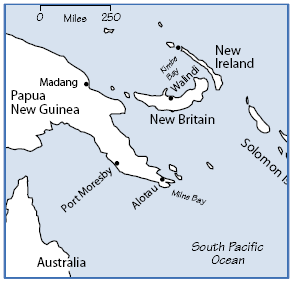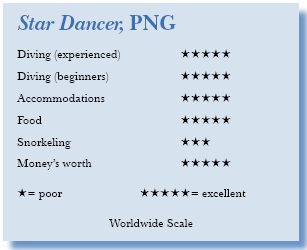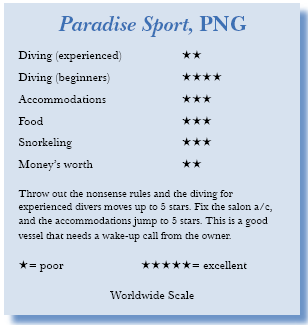Star Dancer, Paradise SportContents of this Issue: Industry Cheerleader? — I don’t think so Editorial Office: Ben Davison Publisher and Editor Undercurrent 3020 Bridgeway, Suite 102 Sausalito, CA 94965 — pick a ship: two top PNG live-aboards from the March, 2005 issue of Undercurrent
Dear Fellow Diver: Papua New Guinea is one of the world's top dive regions, and justifiably so. Much of its reputation is due to the pioneering efforts of expatriate Brit and legendary dive guide Bob Halstead and his wife Dinah, a PNG national. On the Telita they explored PNG from endto- end, mapping dive sites used by all who followed. They also popularized muck diving, a term they coined, discovering sites in less than pristine areas teeming with tiny yet marvelous critters. A few years ago, Peter Hughes moved his 120-foot Sun Dancer from Palau to PNG, and renamed it the Star Dancer. He based it in Kimbe Bay, on the north coast of New Britain Island, running it in tandem with Walindi Resort, owned by Max Benjamin. Max and Alan Raabe, who made his reputation on the Febrina, are partners in the vessel and run it jointly. On my PNG trip, I flew into Port Moresby, then continued on into primitive Hoskins airport on the north coast of New Britain. When we arrived, several passengers were missing checked bags, a common-enough occurrence here. Walindi's driver assured everyone that the gear would arrive on the next flight and he would deliver it. He did. Walindi Resort is an hour's ride from Hoskins, a
pleasant trip in their comfortable, air-conditioned
bus. Twelve bungalows are nestled on the landscaped
grounds overlooking the “beach” (often little more than
tidal flats). Accommodations are rustic, shop-worn, and sparsely furnished, but well-maintained.
In the early autumn, the
heat was oppressive, the humidity
drenching, yet no bungalow is airconditioned.
An overhead fan only
moves the hot air around faster.
After Dancer's ten years of continuous service, the 120-foot, American-built steel vessel shows wear, but the crew was tackling upgrades and redoing one stateroom with new wall coverings, ceilings, paint, and carpet. The main deck holds seven guest staterooms, all with a/c controls, heads, and showers. Two feature queen berths, while the others can be configured into twins or a double. Below deck you can get the “owner's suite,” which sports a bathtub and spans the bow. Up one level is the main salon, where tapes and DVDs are played, and outside is a sitting area –- quite comfortable when gentle sea breezes blow. On the top deck, I logged a nap or two and watched the spectacular sunsets from one of the hammocks. All in all, Dancer is a comfortable craft. Near shore, air temperatures could spike into the high 90s, but once at sea, the cloying humidity was lost and temps were cooler. I made four day dives each day in north Kimbe Bay and along the Witu Islands, mostly on pinnacles with pristine coral, surrounded by deep water. In late October, water temperature averaged 81° F. and visibility averaged 100 feet, at times jumping as high as 150 feet. Healthy populations of tropical reef fish were evident on every dive, including anthias, anemonefish, angelfish, grouper, wrasse, blennies, etc. However, the gorgonia, sea fans, and soft coral growth was not at all profuse, in contrast to the prolific colonies in the nearby Solomon Islands; nonetheless, I had ample chance to capture good soft coral images. I saw plenty of pelagics, too, including tuna, trevally jacks, an occasional wahoo, and schooling barracuda. Once, mantas treated me to serial fly-bys just a few feet away. Another time, a whale shark spent thirty minutes making multiple passes. Twice Capt. Brad Davies set up “shark enticement” dives on pinnacles. He lowered a plastic barrel filled with fish carcasses that didn't feed the fish but emitted a steady scent of chum. The lure produced 45 minutes of dramatic shark action without aggressive behavior –- a bevy of gray reef and silvertip sharks, some as much as 10 feet long, and, at one site, escorted by schools of rainbow runners. In addition, night dives, both on the pinnacles and at good muck diving sites, were offered every other day. (Note: They do not bill this itinerary as a muck-dive route, but the captain did position us in anchorages that afforded excellent macro sites with the usual suspects of orangutan crabs, exotic tiny shrimp, porcelain crabs, and even a pair of harlequin shrimp munching away on a starfish.) Our trip concluded with a dive on a well-preserved WWII Japanese Zero. In fact, the entire crew of eight bustled about constantly, attending to requests, always with smiles. And the food? Fantastic. Chef Andrew produced tasty, varied, and professionally presented meals. Lunches were buffets, and most evening meals were served table-side by staff. Breakfasts offered cereals, fresh fruit, breads, and pastries as well as eggs and omelets. I only had one bad meal -- a too-fishy fish dish most guests left uneaten. The rest of the chow had me asking for seconds, and service was exemplary. The dive staff was great, too, and diving is easy from the Dancer. The ship was at capacity on my trip, with sixteen U.S. divers. On the spacious dive deck, individual lockers provided ample storage, with aluminum 80s efficiently filled in place to between 3000 and 3300 psi; fills were your choice of either air or 32% Nitrox (an extra $200 for ten days). A large camera table accommodated a dozen cameras and strobes that could be charged there or in the main salon or cabins. We dived directly from the stern platform, and the crew was always there to help with gear or handle cameras. When a diver had a regulator malfunction, they gave him a replacement from the rental inventory at no charge. Briefings were to the point, and they made no effort to corral divers into buddy teams. A couple of newer divers were initially shadowed by the guides, who looked after them unobtrusively as they adjusted to live-aboard diving. Veterans were left alone to dive their own plans, unless one requested a critter spotter. Divers staggered their entry times, so there were no crowding problems. Once, we divers donned our snorkeling gear and dropped off the stern platform near a pod of dolphins. Capt. Brad drove the Dancer within 20 feet or so, providing great shots of dolphins cavorting in the bow's pressure wave. My only complaint was that, after a week, the diving had a certain sameness about it, but that didn't bother most divers, so perhaps I'm picking nits. After all, we were treated to virtually unlimited visibility at times, great close-ups of sharks on two dives, and lengthy turtle encounters. The group seemed enthralled, but since all the pinnacles were about the same size and configuration, the dives became a bit predictable. (The ship does offer two other itineraries, one departing from Kavieng on New Ireland, the other featuring the south side of New Britain. I understand these soft coral.) But all-in-all, a little predictability is scarcely enough to dull the luster of my trip. As Ebert and Roeper would say, “two thumbs up” for a first-class operation. After a break in Cairns, Australia, for land touring, I flew back through Port Moresby and on to Alotau to join a diverse group for eight days exploring the excellent muck dives and enjoyable walls, points, and offshore reefs in Milne Bay. My boat was the Paradise Sport, operated by Mike Ball, who also operates the Super Sport and Spoil Sport in Australia. The Paradise Sport operates primarily in PNG's southern region, but it has seasonal routes from Kavieng and Kimbe Bay. The divers on board were a jolly mix of Brits, Canadians, French, Spanish, and half a dozen Yanks. My spacious cabin, shared with an affable Canadian veteran cold water wreck diver, had a large view window, a good-sized shower and head, its own a/c thermostat, and 220 and 110 volt outlets. We had a sizable closet and ample drawers to share; soft-sided luggage went under the bed. The immense main salon, with two large sitting areas and three TV monitors for movies and videos, spanned the width of the vessel. Two long tables held 22 diners with room to spare, even with the buffet set up. However, the a/c was woefully inadequate, especially with the propane stove and oven spewing out not only sweltering heat, but also some rather disagreeable odors. The galley noisily vents its hot and smelly exhaust near the aft outdoor sitting area, so we all stayed away when meals were being prepared. Capt. Larry O'Driscoll, a first-rate shipmaster and retired Aussie naval officer, said he hoped to add additional punch to the a/c during the next refit in Australia. The heat might have been tolerable if the food made up for it, but sadly, meals were the worst I've had on any live-aboard. Maybe this is old-style Aussie cuisine, but meat tended to be overcooked, vegetable side dishes looked like they came from a prison cafeteria, and some seafood was simply inedible. (When another “shark enticement” dive failed to attract a single specimen, I figured they had used galley leftovers.) Since both the Star Dancer and the Paradise Sport provision in equally isolated locales, what's missing is simply a skilled kitchen staff. I lost weight on this trip for the first time ever, and I guess I've got that to be happy about.
For those who were less than fascinated by the unique minutiae that makes macro photographers swoon, nearby reefs offered excellent walls and great coral gardens. Only rarely did selected sites limit divers to macro interests. Some nonphotographers initially expressed frustration, but after a brief introduction to the “small world” subjects, their interests quickly adapted. My impression was that if guests had protested too many afternoon macro sites, their wishes would have been honored. As it was, the selection of sites proved varied and interesting for most everyone. One day, the crew set a deep trap filled with bait and retrieved it with six nautiluses that they hauled up to 60 feet for us photographers. The crew protected these unique and rare deep-water creatures from marauding triggerfish and later escorted them over the drop-off and back to safety in the depths. Water temps here were much cooler (high 70s), making a light wetsuit desirable, though outside it was just as hot, with little rain. Visibility ran 50-75 feet, approaching 100 feet in offshore areas. Another great dive was an intact wreck of a U.S. B-17 Flying Fortress four-engine bomber, perfectly preserved since 1943, that lies upright at 158 feet in the sand next to a sloping wall. The pilot had been losing fuel from bullet holes in his plane's tanks, but he managed to land the bomber right off the island's shore. It skipped over the reef and floated just long enough for the crew to escape, then nearby Boga Boga villagers paddled out and rescued them. (The villagers also welcomed us to their tiny community of stilt houses built next to the beach, offering a view of a lifestyle frozen in time and, in the bargain, selling wonderful carvings, bowls, art work, fabrics, and shells.) Yet, despite the good diving, the diving protocols were enough to drive an experienced diver nuts. Briefings droned on endlessly, and to ensure attendance, a divemaster scoured the ship repeatedly shouting “Dive Briefing!” To dive solo, one was required to carry a pony bottle and second regulator. (Given the excessive baggage charges on Air Niugini, traveling with a pony bottle, mounting bands, and another regulator would have been about as feasible as bringing my own weights.) Several heated encounters took place between the divemasters and veteran underwater photographers, intent on settling in for extended time on macro subjects in 15 feet of water, who'd now been ordered to procure a “buddy.” Most found one, then separated underwater. Nitrox mixes were accomplished via a membrane system. Done properly, the mixes for each tank should be the same, but one had to fill out a log book page for each dive, noting the mix, maximum depth, name, date, and time, then fill out a tank tag with the same information, then furnish the same data to a crew member before the dive –- this with only one oxygen analyzer onboard. There are much simpler means of accomplishing the same objective. Furthermore, divers were told that if they were to go within two minutes of no-decompression limits on their computers, they must sit out the next dive. If you actually dare to go into decompression, you have to sit out for eight hours. The logic made no sense: with different models of dive computers using different calculative algorithms and no-decompression limits, is a diver using a Suunto computer who stays out of deco range safer than a diver using an Oceanic computer, with a more conservative algorithm, who gets within two minutes of his no-deco time? Of course not! And, since the dive crew has no way of knowing if a diver went within two minutes of deco –- or actually went into deco and did a 15-minute hang in the shallows -- what's the point of even having such a rule? Will a diver who shelled out $5,000 for this trip confess to behavior that will cost him a full day of diving he's already paid for?
Ill-conceived rules with threats of penalties can encourage divers to lie about their dive profiles. If a diver who broke the rules developed slight symptoms that could be decompression sickness, he might be less likely to ask for oxygen treatment (which, if administered in the first hour, eliminates symptoms in nearly 80% of DCS cases). The potential for a diver to hide in his cabin concealing symptoms (that will only get harder to treat with delay) simply because he won't admit he didn't confess his sins, is far more troubling than eliminating this ineffective “safety cushion.” Furthermore, decompression diving holds no greater risk than no-decompression diving, as long as one does the required decompression. What's worse is to run close to a no-deco limit and then make a rapid ascent to avoid letting your computer go into deco! Moreover, since Paradise Sport takes divers to a B-17 wreck in 158 feet of water and the crew dictates a schedule requiring nearly 30 minutes of decompression, why are you grounded if you go into a few minutes of deco at the end of four Nitrox dives in a day, never going below eighty feet? Certainly an irritation, but after I returned my editor learned that changes were afoot (see sidebar). Even so, without better a/c and a 21stcentury chef, the Paradise Sport is hard-pressed to be the favored PNG boat, especially for seasoned divers and serious photographers. I've got a hunch this nonsense originated under the previous owner and may not have been completely sorted out in the aftermath. Overall, PNG offers great to excellent diving from several live-aboards and land-based resorts. The region is among the best worldwide for reef quality and marine life diversity, although, like the Solomons, getting there can be a trial, and crime-ridden Port Moresby is best avoided. But the outlying settlements are friendly and the diving well worth the effort. |

I want to get all the stories! Tell me how I can become an Undercurrent Online Member and get online access to all the articles of Undercurrent as well as thousands of first hand reports on dive operations world-wide
| Home | Online Members Area | My Account |
Login
|
Join
|
| Travel Index |
Dive Resort & Liveaboard Reviews
|
Featured Reports
|
Recent
Issues
|
Back Issues
|
|
Dive Gear
Index
|
Health/Safety Index
|
Environment & Misc.
Index
|
Seasonal Planner
|
Blogs
|
Free Articles
|
Book Picks
|
News
|
|
Special Offers
|
RSS
|
FAQ
|
About Us
|
Contact Us
|
Links
|
3020 Bridgeway, Ste 102, Sausalito, Ca 94965
All rights reserved.

 Next time, I'd choose to arrive the
day of departure and go directly to
the air-conditioned Dancer.
Next time, I'd choose to arrive the
day of departure and go directly to
the air-conditioned Dancer. The Paradise Sport is a sturdy aluminum twin-diesel catamaran, just under
100 feet long but nearly 30 feet wide, so the sense of size is dramatic.
There is ample storage for both
dive gear and photo equipment,
and a dive deck that's both efficient
and well laid out, easily
accommodating our eighteen divers.
However, the deck is always
a flurry of activity and can
be noisy during tank fillings
(which always left the aluminum
80s filled to 3000 psi). Like
the Star Dancer, though, no noise
intrudes into the staterooms or
salon.
The Paradise Sport is a sturdy aluminum twin-diesel catamaran, just under
100 feet long but nearly 30 feet wide, so the sense of size is dramatic.
There is ample storage for both
dive gear and photo equipment,
and a dive deck that's both efficient
and well laid out, easily
accommodating our eighteen divers.
However, the deck is always
a flurry of activity and can
be noisy during tank fillings
(which always left the aluminum
80s filled to 3000 psi). Like
the Star Dancer, though, no noise
intrudes into the staterooms or
salon. Milne and Goodenough Bays
have some of the best macro and
muck diving sites in the world,
including famed Dinah's Beach
(discovered by Halstead's wife). The prolific tropical fish populations
include rare anemonefish
in almost unbelievable colorations,
rhinopias in two phases,
clouds of anthias, and a potpourri
of angelfish species. The
muck sites really weren't all
that “mucky.” They usually showcased
great critters and tremendous
macro subjects in clear
water over mostly volcanic black
sand. These areas have, justifiably,
made PNG's reputation.
Several sites were so compelling
that some divers spent the entire
day underwater, rarely below 40
feet, surfacing only for a meal
before jumping back to view Indo-
Pacific species not seen outside
this part of the world. While I'm
reasonably versed in critter identification, I was helpless without the aid
of such books as Halstead's Dive Sites of Indonesia or Rob van der Loos'
invaluable Living Reefs of the Indo-Pacific (check out these books online
at
Milne and Goodenough Bays
have some of the best macro and
muck diving sites in the world,
including famed Dinah's Beach
(discovered by Halstead's wife). The prolific tropical fish populations
include rare anemonefish
in almost unbelievable colorations,
rhinopias in two phases,
clouds of anthias, and a potpourri
of angelfish species. The
muck sites really weren't all
that “mucky.” They usually showcased
great critters and tremendous
macro subjects in clear
water over mostly volcanic black
sand. These areas have, justifiably,
made PNG's reputation.
Several sites were so compelling
that some divers spent the entire
day underwater, rarely below 40
feet, surfacing only for a meal
before jumping back to view Indo-
Pacific species not seen outside
this part of the world. While I'm
reasonably versed in critter identification, I was helpless without the aid
of such books as Halstead's Dive Sites of Indonesia or Rob van der Loos'
invaluable Living Reefs of the Indo-Pacific (check out these books online
at  Diver's Compass: Peter Hughes Diving (Star Dancer), 1-800-
9DANCER,
Diver's Compass: Peter Hughes Diving (Star Dancer), 1-800-
9DANCER, 